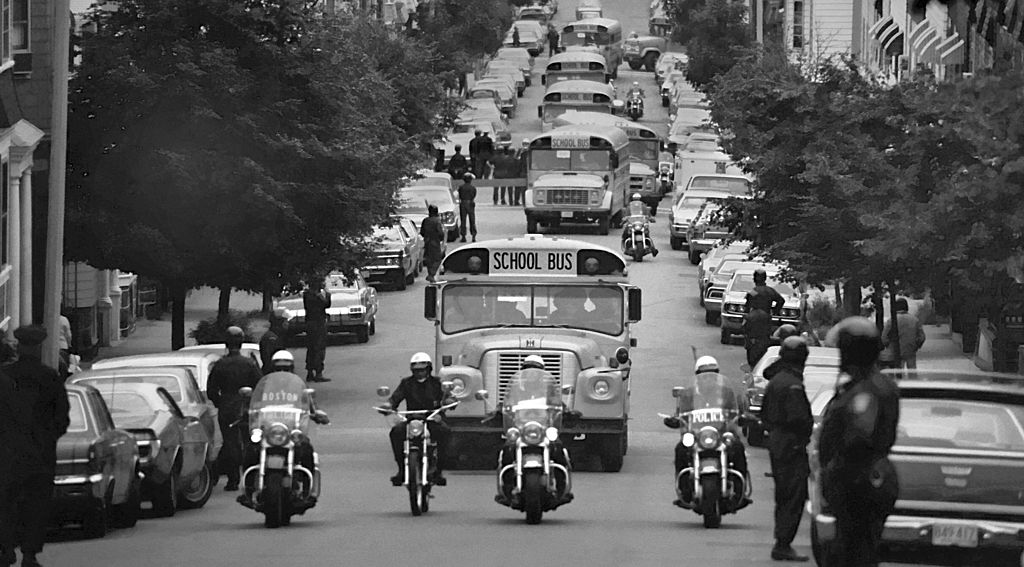
Busing, the transporting of public school children to end racial segregation, was thrust back into national conversations when Senator Kamala Harris criticized Vice President Joe Biden, over his record on it at the first Democratic presidential debate.
But while her words sparked a renewed conversation about the subject, busing itself has been dead for 20 years this month. Busing is a complex issue. I know this from both my personal and professional experience. I also know that the re-segregation of public schools means separate but unequal opportunities for African-American children.
Like Kamala Harris, I was bused. Like Harris, I went to law school. In 1999, as a young civil rights attorney for the NAACP Legal Defense Fund, my caseload included the landmark busing case Swann v Charlotte-Mecklenburg Board of Education in North Carolina, in which white parents challenged busing and won.
When Brown v. Topeka Board of Education, in 1954, uprooted the racial segregation begun under Plessy v. Ferguson in 1896, the battle over segregation did not end. First, the Supreme Court ruled segregated public schools were unconstitutional. Then, in 1955, the Court decided the lesser-known Brown II case, requiring public schools to desegregate “with all deliberate speed.” They didn’t.
Instead, white parents left for the suburbs, created Christian schools, formed White Citizens’ Councils and filed lawsuits. Virginia even closed its public schools to avoid desegregation. In 1971, the U.S. Supreme Court ruled in favor of busing as a way to end racial segregation because African-American children were still attending segregated schools. White children had been riding school buses for decades, but the idea of using the same mechanism to desegregate public schools triggered violent protests.
My hometown of Kansas City, Mo., fought desegregation, though not as viciously as Boston, where adults attacked buses carrying African-American children desegregating white schools. Still, I awoke before sunrise and rode school busses crisscrossing Kansas City. Strangers appeared in my high school classrooms with clipboards, asking questions. After they left, African-American students were moved next to white students. I was asked to run for class office and an African-American teacher was promoted to vice-principal. The strangers had been civil rights attorneys trying to erase vestiges of segregation.
Decades later, as a civil rights attorney myself, I watched the busses crisscross Charlotte-Mecklenburg’s 546 square miles. I checked for signs of racial inequality in classrooms, libraries, teacher salaries and extracurricular activities. The diverse student population inside Charlotte-Mecklenburg buildings belied its racially segregated classrooms. Instead of skin color, test scores and vocational tracking became a way to keep the color line. African-American children were disproportionally expelled. There remained work to do.
When white parents in North Carolina sued to end busing, Judge Robert Potter, who had actively worked against busing before ascending to the bench, presided over the case. He ruled that Charlotte-Mecklenburg schools were no longer segregated. It was Sept. 11, 1999. An appeal failed. Court-ordered busing was over.
Not all whites viewed busing as a loss of race-based power. But even those few school districts trying to voluntarily desegregate through busing were stopped, in 2007, by Chief Justice John Roberts, who wrote, “The way to stop discrimination on the basis of race is to stop discriminating on the basis of race.” He ruled, in effect, that not allowing a minority of white parents their school of choice was discrimination.
African-American communities bore the brunt of both segregation and busing. Separate was never equal. Instead of repairing or building schools, ours were torn down. Lost were locations of cultural pride, meeting places for dances where teenage awkwardness was not exacerbated by race. Busing meant African-American children, like me, withstood prejudice and loneliness.
Twenty years later, Charlotte-Mecklenburg and Kansas City schools are re-segregating. In fact, a report from UCLA’s Civil Rights Project and the Center for Education and Civil Rights, found that, in 2016, 40% of African-American students nationwide were in schools with 90% or more students of color. In New York City, where I live, controversy around segregated public schools is tragically similar to my early years. The benefit of desegregation, then and now, is the breakdown of racial stereotypes. This diverse nation cannot afford to live in silos of distrust and ignorance of one another.
Busing was essential to breaking segregation’s stranglehold. It was also a polarizing symbol, weighed down by racist fears and unrealistic expectations. But for African-American parents, like mine, busing was a chance worth taking. For me, and perhaps Kamala Harris, the scars and benefits of busing are a daily reminder of this nation’s short-lived attempt at addressing its past.
Educational equality is a form of reparations and an investment in America’s future. America created apartheid with Plessy v. Ferguson. Any desegregation plans must be a shared burden. But are we willing to take it on?
More Must-Reads from TIME
- Why Biden Dropped Out
- Ukraine’s Plan to Survive Trump
- The Rise of a New Kind of Parenting Guru
- The Chaos and Commotion of the RNC in Photos
- Why We All Have a Stake in Twisters’ Success
- 8 Eating Habits That Actually Improve Your Sleep
- Welcome to the Noah Lyles Olympics
- Get Our Paris Olympics Newsletter in Your Inbox
Contact us at letters@time.com